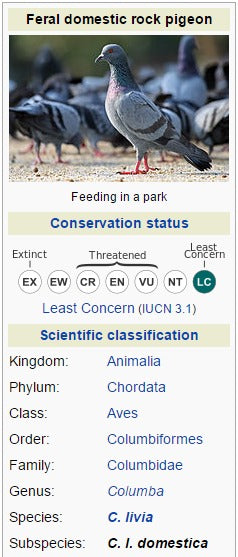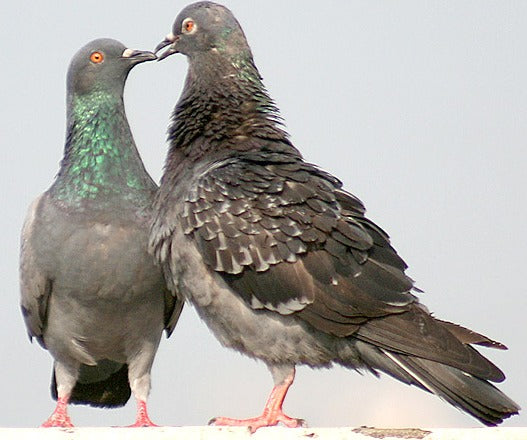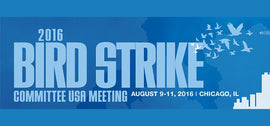
Feral pigeons (Columba livia domestica), also called city doves, city pigeons or street pigeons, are derived from domestic pigeons that have returned to the wild. The domestic pigeon was originally bred from the wild rock dove, which naturally inhabits sea-cliffs and mountains. Rock (i.e., 'wild'), domestic and feral pigeons are all the same species and will readily interbreed. Feral pigeons find the ledges of buildings to be a substitute for sea cliffs, have become adapted to urban life, and are abundant in towns and cities throughout much of the world.
According to the current belief that doves mate for life, wild, domestic and feral pigeons form long-term bonds, although not unbreakable ones. They are socially monogamous, but extra-pair matings do occur, often initiated by males.
 Courtship rituals can be observed in urban parks at any time of the year. The male on the ground or rooftops puffs up the feathers on his neck to appear larger and thereby impress or attract attention. He approaches the hen at a rapid walking pace while emitting repetitive quiet notes, often bowing and turning as he comes closer. At first, the female invariably walks or flies a short distance away and the male follows her until she stops. At this point, he continues the bowing motion and very often makes full- or half-pirouettes in front of the female. The male then proceeds to feed the female by regurgitating food, as they do when feeding the young.The male then mounts the female, rearing backwards to be able to join their cloacae. The mating is very brief with the male flapping his wings to maintain balance on top of the female.
Courtship rituals can be observed in urban parks at any time of the year. The male on the ground or rooftops puffs up the feathers on his neck to appear larger and thereby impress or attract attention. He approaches the hen at a rapid walking pace while emitting repetitive quiet notes, often bowing and turning as he comes closer. At first, the female invariably walks or flies a short distance away and the male follows her until she stops. At this point, he continues the bowing motion and very often makes full- or half-pirouettes in front of the female. The male then proceeds to feed the female by regurgitating food, as they do when feeding the young.The male then mounts the female, rearing backwards to be able to join their cloacae. The mating is very brief with the male flapping his wings to maintain balance on top of the female.
Abandoned buildings are favorite nesting areas. Mass nesting is common as pigeons are a community flocking bird; often, dozens of birds share a building. Loose tiles and broken windows provide access, and pigeons are adept at spotting new access points, for example following property damage caused by strong winds.
Newly hatched squab on the base of a bathroom's ventilator window, nests and droppings tend to stay clustered and remain dry when out of the weather. Pigeons are particularly fond of roof spaces. These often contain water tanks. Any water tank or cistern on a roof must, therefore, be secured and sealed off to keep the pigeons out of them. The popularity of a nesting area does not seem to be affected by the pigeons' population density.
 Pigeon squab nest on undamaged property, the gutters, window air conditioners and empty air conditioner containers, chimney pots and external ledges are used as nesting sites. Many building owners try to limit roosting by using bird control spikes and netting to cover ledges and potential nesting places on buildings. This has little effect on the size of the pigeon population, but it can reduce the accumulation of droppings on and around a particular building location.
Pigeon squab nest on undamaged property, the gutters, window air conditioners and empty air conditioner containers, chimney pots and external ledges are used as nesting sites. Many building owners try to limit roosting by using bird control spikes and netting to cover ledges and potential nesting places on buildings. This has little effect on the size of the pigeon population, but it can reduce the accumulation of droppings on and around a particular building location.
Pigeons breed when the food supply is abundant enough to support embryonic egg development, which in cities can be any time of the year. Laying of eggs can take place up to six times per year.
Pigeons are often found in pairs during the breeding season, but usually the pigeons are gregarious, living in flocks of 50 to 500 birds (dependent on the food supply).
Feral pigeons can be seen eating grass seeds and berries in parks and gardens in the spring, but plentiful sources exist throughout the year from scavenging (e.g., remnants left inside of dropped fast-food cartons) and they also take insects and spiders. Additional food is also usually available from the disposing of stale bread in parks by restaurants and supermarkets and from tourists buying and distributing birdseed, etc. Pigeons tend to congregate in large, often thick flocks when feeding on discarded food, and have been observed flying skillfully around trees, buildings, telephone poles, and cables, and even through moving traffic just to reach a food source.
Find similar articles
Pigeons



